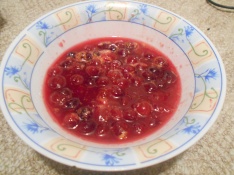As I stood watching my cranberries cook, waiting for them to pop in the pot, I thought what a shame it is that cranberries (and blueberries and bayberries!) are so hard to grow in our alkaline soil. My mind wandered to the pioneers, who couldn’t just buy cranberries at the store, and I wondered what they had for their Thanksgiving dinners. I’ve read a lot of pioneer accounts and journals, scouring them for mentions of plants and food, and I don’t remember ever seeing any mention of Thanksgiving. The official date for Thanksgiving was set by Abraham Lincoln during the Civil War (in 1863–so fourth Thursday Thanksgiving is celebrating its 150th anniversary this year!), but even by that time Thanksgiving was a well-established tradition that pioneers with American or Canadian roots must have brought to Utah with them. I decided to do a little digging.
I still don’t have any direct accounts of a pioneer Thanksgiving harvest celebration, but I picked up a few hints. By the late 1800s, the Desert News reported that most church denominations in the Salt Lake Valley held special Thanksgiving services. At the same time, the newspaper ran ads that echo our modern Black Friday frenzies, admonishing housewives to get to the store and buy everything they need for their house at special Thanksgiving prices (apparently Irish satin table damask was a must-have, starting at 73 cents for a table cloth).
A Deseret News article from November 22, 1927 tells us that traveling to visit family and watching football games were already entrenched holiday traditions in Utah, though the article claims that in bygone days, men would go out at dawn to hunt for quail, duck, or grouse to supplement the feast, while women prepared domestic fowl for the Thanksgiving table, and that the holiday was once more of a remembrance of the bounties of the soil necessary for survival during Utah’s pioneer period.
These comments made me realize how strongly tradition reigns over some holidays (my family even has an early morning target shoot each Thanksgiving), but didn’t tell me much about how the early Utah pioneers celebrated. We know they held feasts and parades on Pioneer Day (in July) from an early date as a type of Thanksgiving celebration. I found an account from Elizabeth Kane, who visited Utah in the winter of 1870 with her husband Thomas Kane. She didn’t mention Thanksgiving, but describes some of the foods typical of a wintertime feast: apple fritters; jellies made from wild plums, cranberries, and currants; winter vegetables (perhaps carrots and potatoes); mince pies; smoking plum puddings; preserves; tarts; pears, peaches, apples, and grapes; and homemade wine. I would love to know how the pioneers got peaches to last into the winter! But unless Kane was mistaken, at least some of the pioneers managed to have cranberries.
In honor of their cranberry jellies, and in gratitude for the convenience of grocery stores, here’s a yummy, quick, and easy cranberry sauce recipe made with honey instead of sugar (though you could use sugar, and this year I used agave nectar). Unfortunately I don’t remember where I found the original or how I’ve modified it over the years, but here it is:
Honey Cranberry Sauce
2 cups cranberries, rinsed and checked for stems
1 cup apple, orange, or pineapple juice
1/2 c honey or other sweetener
1/4 tsp cinnamon
1/4 tsp ginger
Mix all the ingredients in a pot and cook on the stove over low heat until the cranberries pop–about 10 minutes. Remove from heat and cool to room temperature–the sauce should gel. Some years it sets better than others for me, and I think one of the keys is to disturb it as little as possible while it’s cooling. Store, covered, in the fridge for up to a week.
Happy Thanksgiving!

